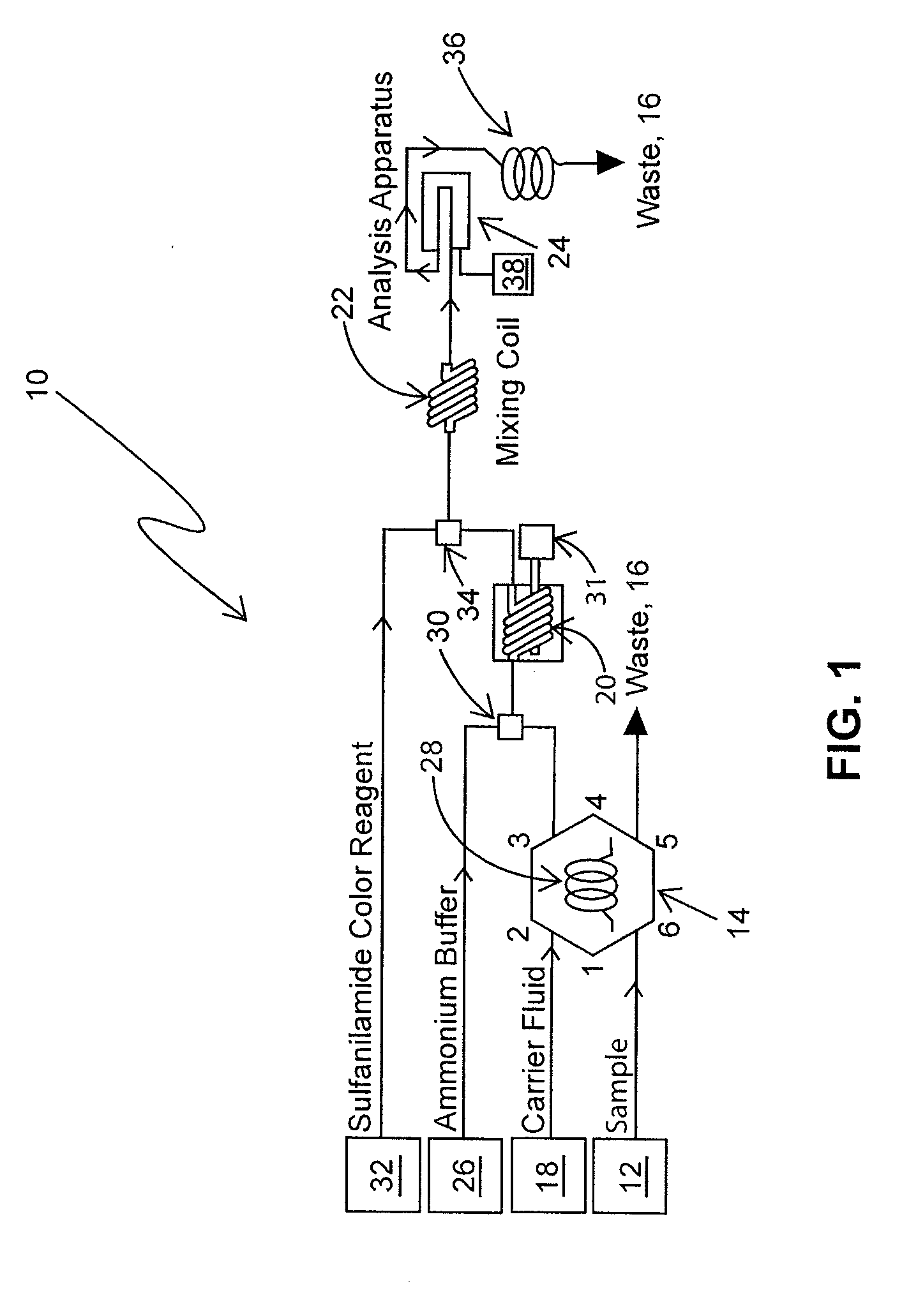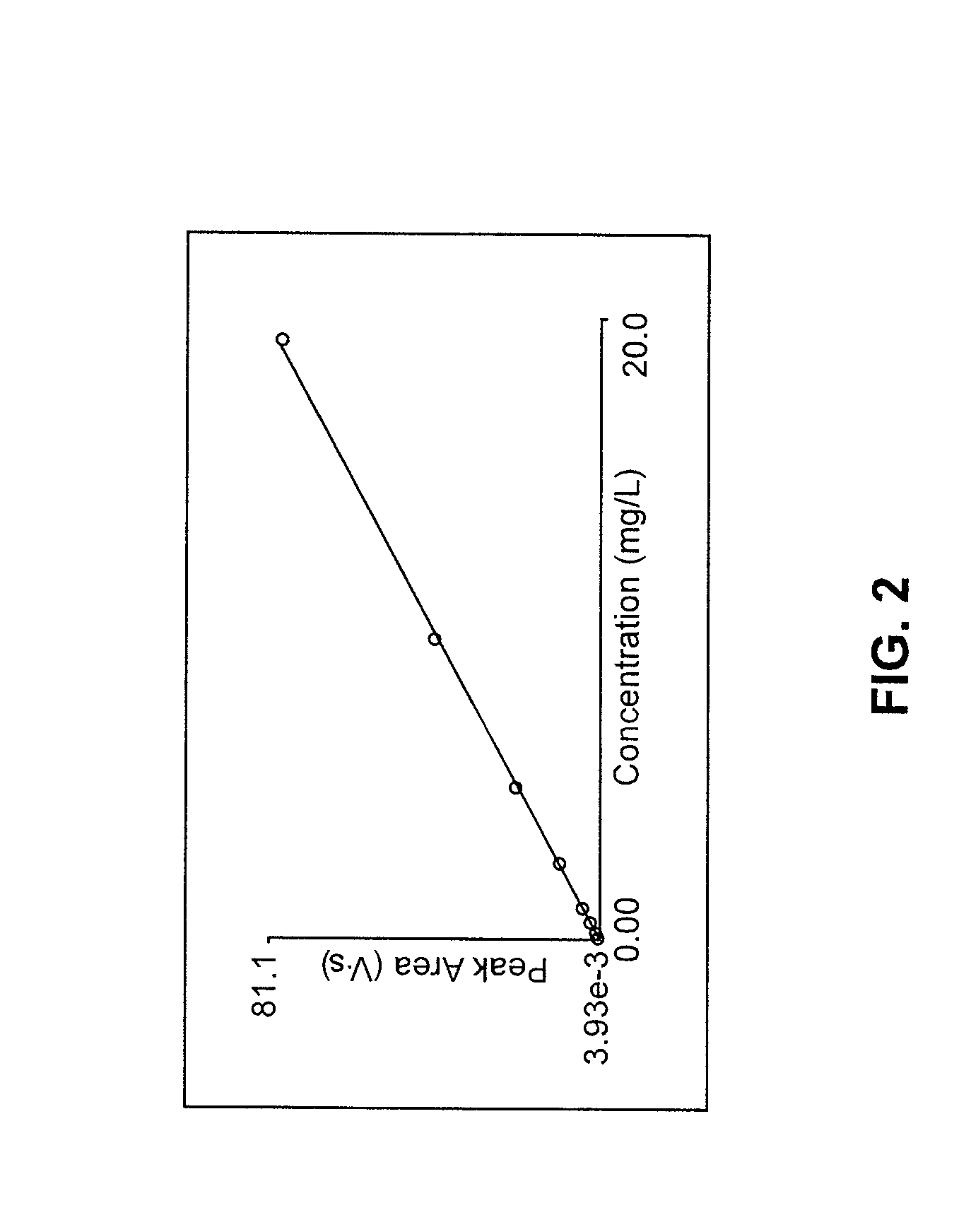Determination of nitrate/nitrite concentration in water by photochemical reduction
a technology of photochemical reduction and nitrate concentration, which is applied in the direction of biological material analysis, material analysis, instruments, etc., can solve the problems of increased turbidity and oxygen depletion, respiratory failure, and destruction of life in such waterways, and achieve the effect of reducing efficiency
- Summary
- Abstract
- Description
- Claims
- Application Information
AI Technical Summary
Benefits of technology
Problems solved by technology
Method used
Image
Examples
example 1
Reagents for General Water Analyses
[0028]Deionized (DI) water (10 MΩ) is used for all solutions. To prevent bubble formation during analysis, all solutions except the standard solutions are degassed using helium.
[0029]A. 15 N Sodium Hydroxide: by volume, add 150 g of NaOH to 250 mL or g of deionized (DI) water; swirl until dissolved; cool; and store in a plastic bottle.
[0030]B. Ammonium Chloride buffer, pH 8.0±0.1:
[0031]1. by volume, 85.0 g ammonium chloride (NH4Cl) and 4.0 g of disodium ethylenediamine tetraacetic acid dihydrate (Na2EDTA·2H2O) are dissolved in about 800 mL of DI water in a 1 L volumetric flask; the mixture is diluted to 1 L, and mixed; and the pH is adjusted to 8.0 using the 15 N sodium hydroxide solution; or
[0032]2. by weight, 85.0 g of ammonium chloride (NH4Cl), and 4.0 g disodium ethylenediamine tetraacetic acid dihydrate (Na2EDTA·2H2O) are added to 938 g of DI water in a tared container; the mixture is shaken or stirred until the solids are dissolved; and the p...
example 2
Reagents for Sea and Brackish Waters
[0045]Deionized (DI) water (10 MΩ) is used for all solutions. To prevent bubble formation during analysis, all solutions except the standard solutions are degassed using helium.
[0046]A. 15 N Sodium Hydroxide: by volume, add 150 g of NaOH to 250 mL or g of deionized (DI) water; swirl until dissolved; cool; and store in a plastic bottle.
[0047]B. Ammonium Chloride buffer, pH 8.2±0.1:
[0048]1. by volume: dissolve 85.0 g ammonium chloride (NH4Cl) and, for high nitrate concentration ranges (water samples having concentrations between about 0.2 and about 20 mg N / L as NO3− or NO2−) dissolve 10.0 g, and for low nitrate concentration ranges (water samples having concentrations between about 0.05 and about 5.0 mg N / L as NO3− or NO2−) dissolve 15 g disodium ethylenediamine tetraacetic acid dihydrate (Na2EDTA·2H2O) in about 800 mL DI water in a 1 L volumetric flask; dilute to 1 L and invert to mix; and adjust the pH to 8.2±0.1 with 15 N sodium hydroxide solutio...
example 3
Reagent Formulations for 2 M KCl Extracts (Common for Soil Analyses, where the KCl Solution is used to Extract Nitrates from the Soil Sample, as an Example)
[0065]Deionized (DI) water (10 MΩ) is used for all solutions. To prevent bubble formation during analysis, all solutions except the standard solutions are degassed using helium.
[0066]A. 15 N Sodium Hydroxide: by volume, add 150 g of NaOH to 250 mL or g of deionized (DI) water; swirl until dissolved; cool; and store in a plastic bottle.
[0067]B. Ammonium Chloride Buffer Solution having a pH of 8.2±0.1:
[0068]1. by volume: dissolve 85.0 g ammonium chloride (NH4Cl) and 5.5 g of disodium ethylenediamine tetraacetic acid dihydrate (Na2EDTA·2H2O) in about 800 mL of DI water in a 1 L volumetric flask; dilute to 1 L; invert to mix; and adjust the pH to 8.2±0.1 with 15 N sodium hydroxide solution;
[0069]2. by weight: add 85.0 g ammonium chloride (NH4Cl) and 5.5 g of disodium ethylenediamine tetraacetic acid dihydrate (Na2EDTA·2H2O) to 938 g ...
PUM
 Login to View More
Login to View More Abstract
Description
Claims
Application Information
 Login to View More
Login to View More - R&D
- Intellectual Property
- Life Sciences
- Materials
- Tech Scout
- Unparalleled Data Quality
- Higher Quality Content
- 60% Fewer Hallucinations
Browse by: Latest US Patents, China's latest patents, Technical Efficacy Thesaurus, Application Domain, Technology Topic, Popular Technical Reports.
© 2025 PatSnap. All rights reserved.Legal|Privacy policy|Modern Slavery Act Transparency Statement|Sitemap|About US| Contact US: help@patsnap.com


